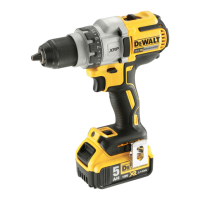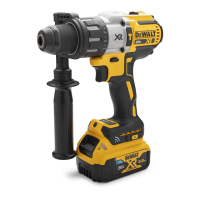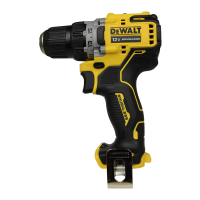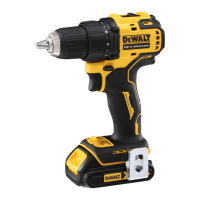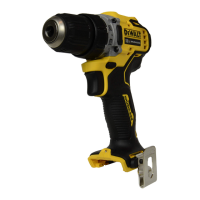English
17
2. Reset the torque adjustment collar 5 to the
appropriate number setting for the torque desired.
Make a few practice runs in scrap or unseen areas
to determine the proper position of the torque
adjustment collar.
nOTE: The torque adjustment collar may be set to any
number at any time.
Drill Operation (Fig. A)
WARNING: TO REDUCE THE RISK OF PERSONAL
INJURY, ALWAYS ensure workpiece is anchored or
clamped firmly. If drilling thin material, use a wood
“back
‑
up” block to prevent damage to the material.
1. Select the desired speed/torque range using the
gear shifter 8 to match the speed and torque to
the planned operation. Set the torque adjustment
collar 5 to the drill symbol.
2. For WOOD, use twist bits, spade bits, power auger
bits or hole saws. For METAL, use high‑ speed steel
twist drill bits or hole saws. Use a cutting lubricant
when drilling metals. The exceptions are cast iron
and brass which should be drilled dry.
3. Always apply pressure in a straight line with the bit.
Use enough pressure to keep the drill bit biting, but
do not push hard enough to stall the motor or
deflect the bit.
4. Hold tool firmly with both hands to control the
twisting action of the drill.
5. iF DRill sTAlls, it is usually because it is being
overloaded. RElEAsE TRiggER iMMEDiATElY,
remove drill bit from work, and determine cause of
stalling. DO nOT CliCK TRiggER OFF AnD On in An
ATTEMPT TO sTART A sTAllED DRill – This CAn
DAMAgE ThE DRill.
6. Keep the motor running when pulling the bit back
out of a drilled hole. This will help prevent
jamming.
Hammerdrill Operation (Fig. A)
1. Select the desired speed/torque range using the
gear shifter to match the speed and torque to the
planned operation. Set the torque adjustment
collar 5 to the hammer symbol.
2. Select the high speed 3 setting by sliding the gear
shifter 8 back (away form the chuck).
3. When drilling, use just enough force on the
hammer to keep it from bouncing excessively.
Prolonged and too much force on the hammer will
cause slower drilling speeds and potential
overheating.
4. Drill straight, keeping the bit at a right angle to the
work. Do not exert side pressure on the bit when
drilling as this will cause clogging of the bit flutes
and a slower drilling speed.
5. When drilling deep holes, if the hammer speed
starts to drop off, pull the bit partially out of the
hole with the tool still running to help clear debris
from the hole.
6. For masonry, use carbide‑ tipped bits or masonry
bits. A smooth, even flow of dust indicates the
proper drilling rate.
MAINTENANCE
Your power tool has been designed to operate over a
long period of time with a minimum of maintenance.
Continuous satisfactory operation depends upon
proper tool care and regular cleaning.
WARNING: To reduce the risk of serious
personal injury, turn tool off and disconnect
battery pack before making any adjustments
or removing/ installing attachments or accessories.
An accidental start
‑
up can cause injury.
The charger and battery pack are not serviceable.
C
Lubrication
Your power tool requires no additional lubrication.
D

